
 ne of things I did when I knew that I would be going to San Diego for 3 months, was to search on the Internet for diving opportunities there, after all the city is just by the sea. I was really excited when I found out that I would be able to dive in the kelp forests found off the coast of south California, and that there were a number of dive operators offering such dives. The dive destinations included Los Coronados, a group of islands located in Mexican waters just across the border, 25 km south of San Diego. However, disappointment soon overcame me when I realised that surface temperatures ranged from 14° C to 16° C in February in San Diego. I would be in San Diego from February till end of April, so I started searching for write-ups on diving in the area during this period. Things didn't look bright. 20° C is considered high, 15-mm wet suits with hoods are needed, and divers had reported to be happy only with dry suits. It was too late to call up YC for a dry-suit course; I found out that such a course costs about US$1,600 in the U.S., and the dive operators usually don't rent dry-suits. So I resigned to having to dive with thick wet suits, and I pictured myself struggling to squeeze into a 15-mm wet suit.
ne of things I did when I knew that I would be going to San Diego for 3 months, was to search on the Internet for diving opportunities there, after all the city is just by the sea. I was really excited when I found out that I would be able to dive in the kelp forests found off the coast of south California, and that there were a number of dive operators offering such dives. The dive destinations included Los Coronados, a group of islands located in Mexican waters just across the border, 25 km south of San Diego. However, disappointment soon overcame me when I realised that surface temperatures ranged from 14° C to 16° C in February in San Diego. I would be in San Diego from February till end of April, so I started searching for write-ups on diving in the area during this period. Things didn't look bright. 20° C is considered high, 15-mm wet suits with hoods are needed, and divers had reported to be happy only with dry suits. It was too late to call up YC for a dry-suit course; I found out that such a course costs about US$1,600 in the U.S., and the dive operators usually don't rent dry-suits. So I resigned to having to dive with thick wet suits, and I pictured myself struggling to squeeze into a 15-mm wet suit.

About 2 weeks after my arrival in San Diego, I contacted a dive operator who only started going out to sea in March; I wrote an e-mail to them reserving a place for myself to Los Coronados on 8 March (Saturday). About 5 days before the dive, I was thinking about canceling my reservation. I had been feeling cold everyday since my arrival in San Diego. I was relieved but at the same time disappointed, when I called the operator and found out that the trip had been cancelled because their boat was not ready. That weekend turned out to be very sunny and warm.
The following Monday, I called up another dive operator, Blue Escape (http://www.blueescape.com) and booked a place to Los Coronados for Saturday. The sun kept up its appearance as the week went by, and I was really looking forward to the dive. Then on Friday, the weather report gave a forecast of a stormy weekend! I stoically decided not to be disappointed, to ignore the weather forecast and to go for the trip. Friday night, I packed the gear I had brought along - mask, snorkel, fins, booties, gloves, compass and Suunto dive computer. I would be renting the rest of the gear needed for the dive. Then I set the alarm clock to go off at 4.45 a.m. and went to bed at 11.00 p.m.
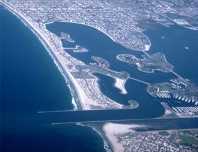 Saturday morning, when the alarm clock went off, I silenced it and almost went back to sleep. Then I remembered that I had to catch the 5.45 a.m. bus to go down to Mission Bay. I struggled out of bed, went to the bathroom and splashed my face with cold water to shock myself into 100% wakefulness. Then I decided that a substantial breakfast would be a good preparation for the day, so I cooked up a mushroom omelette to go with my bread and washed down all of that with a cup of hot black coffee.
Saturday morning, when the alarm clock went off, I silenced it and almost went back to sleep. Then I remembered that I had to catch the 5.45 a.m. bus to go down to Mission Bay. I struggled out of bed, went to the bathroom and splashed my face with cold water to shock myself into 100% wakefulness. Then I decided that a substantial breakfast would be a good preparation for the day, so I cooked up a mushroom omelette to go with my bread and washed down all of that with a cup of hot black coffee.
The morning was still cold, so I pulled on a sweater on top of my Giordano T-shirt, and then added a thin jacket to the ensemble. Fearing cold weather out at sea, I stowed another sweater in my bag. I shouldered my bag, put my fins under my arm and proceeded to the bus-stop. It was 5.40 a.m. but the day was already brightening. The #34 bus arrived as dictated by the time-table. I boarded the bus, greeted the driver and paid up the US$2.00 for the 65-minute ride to Mission Bay. In the bus, I took out my Suunto Solution α and turn it on. It was 20° C in the bus.
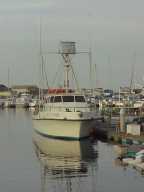 The Blue Escape dive shop was just 20 metres away from the bus-stop at Mission Bay. It was 6.50 a.m. when I reached the shop, it was still closed. I walked to a nearby seafood chow shop facing the Mission Bay marina and settled down to wait. The Blue Explorer, the boat that would be taking me for the dive, was waiting in the marina. It was quiet at first; then a few minutes later, a couple of guys arrived to look around their boats. One of them turned out to be the captain of the Blue Explorer. Then two more guys turned up with wheeled bags, it was obvious they were divers.
The Blue Escape dive shop was just 20 metres away from the bus-stop at Mission Bay. It was 6.50 a.m. when I reached the shop, it was still closed. I walked to a nearby seafood chow shop facing the Mission Bay marina and settled down to wait. The Blue Explorer, the boat that would be taking me for the dive, was waiting in the marina. It was quiet at first; then a few minutes later, a couple of guys arrived to look around their boats. One of them turned out to be the captain of the Blue Explorer. Then two more guys turned up with wheeled bags, it was obvious they were divers.
At 7.05 a.m. I went back to the dive shop, it was still closed but somebody had posted a note on the door, saying that he had gone to get lunch for everybody on the dive trip. A tall man was waiting nearby, he had beside him his dive bag and a scuba tank.
Very soon, the shop opened, and more divers started arriving. A group of about 8 divers were there to go for a trip to the Yukon wreck. A father and son duo, who were also to come along to Los Coronados, arrived and started trying out for wet suits and BCs. I signed the indemnity form and asked to try out a wet suit. I was handed a size-XL 6-mm farmer-john suit, I hesitated a while and realised that I wasn't going to get a thicker one. The father and son duo was using the sole dressing cabin, and a girl was waiting to use it to change into her swimming costume. So I tried out the farmer-john suit in the storeroom. I had to struggle hard to get into the suit, and I was glad that it wasn't 15-mm. At the same time I was trying to block out the doubt that the 6-mm suit would keep the cold out underwater. When I finally got into it and velcroed the shoulder strap, it fitted me snugly. I browsed through the hanging suits and found a size-XL jacket; but it won't zip up after I had struggled to pushed my arms through the sleeves. I had to get a size-XXL jacket, a sign of my fatness. Then I tried out a size-XL hood. I collected a BC and a regulator set, bundled them with the wet suit and carried them to the Blue Explorer. The tanks were all charged and loaded up in the boat. Each diver would have 3 tanks for the day.
The tall man was already aboard the Blue Explorer. We introduced ourselves. Charles Reurup, environmental engineer. He has driven all the way from Arizona the previous night to go on this dive trip! Then the captain appeared to get our names for the manifest, he introduced himself as Sean. Then the father and son duo arrived, and then came 2 men with wheeled dive bags, with John the divemaster. The team was complete, there would only be 6 divers on the trip.
Before setting out for Los Coronados, Sean gave a briefing about the boat and some coast guard regulation. After the 5-minute briefing, the boat chugged out of Mission Bay into the sea, and headed south for Los Coronados. The sea was slightly choppy. The sky was overcast and gray. Everyone on the boat was hoping that the storm would hold out for the day.
15 minutes out to the sea, John announced that a pot of hot coffee had just been brewed. Charlie and I made our way to the cabin to get the coffee, and found out that some hot pastries were also available. So I had my second breakfast for the day.
The boat chugged on for about an hour before Coronado del Norte, the northern-most island of the group which is our destination, came into sight. But we still had about another hour to go before reaching the it. Meanwhile, the overcast sky obtusely refused to let the sun out, even in the next hour. Along the way, we spotted a number of dolphins gallivanting just under the water surface, but never near our boat. Solitary pelicans and gulls swept the gray sky. As we near the North Island, we spotted a boat of whale watchers. They were trying to get near the small grey whale that was spouting near the surface. Then a fin flipped above the water surface, as if to wave at the watchers.
On our boat, everyone started to kit up. I had already fitted the BC and regulator set to my designated aluminum tank. The content gauge read 3000 psi when I turned on the air. So I got my farmer-john suit and went into the cabin to change. Having tried it on at the dive shop, I knew how to get into it this time without any unnecessary hassle. Then I put on the jacket and left it unzipped. It was very comfortable, and I was immune to the chilly wind then! By then the two guys with the wheeled bags had unpacked an underwater video ensemble and were struggling into their dry suits. Hmm ... I tried to ignore the fact that I had only a 6-mm wet suit on, okay I had two layers on my torso, but my gloves were 3-mm and I had only ankle height booties! I hoped I would not be exposing too much of myself. I unpacked my Suunto Solution α, and turned it on. Hmm, ..., 16° C. How much colder would it be below? I conveniently pushed the question to the nethermost region of my mind.
Sean brought us to the site they called "The Keyhole". It is a rocky promontory to the south-east of the island, with a door-size hole through it. The waves were getting stronger and crashing through the "keyhole". Decidedly, it was not a day to try and dive the site. So the boat went to the "Lobster Shack", a sheltered cove on the eastern side of the island. Despite the name, there was neither a shack along the rocky coast, nor were there any lobsters in the waters. The lobsters having been completely fished out by the Mexicans and the shack had completely collapsed and blown off through years of disuse. However, there was a group of sea lions playing in the cove, and along the coast.
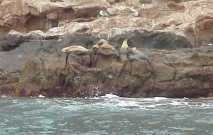 John then briefed us on the site, and on how to behave with the sea lions. They are very playful and would try to imitate divers' movements. However, they are not entirely harmless. They may try to bite the fins or any obvious protrusions, so don't stretch out your arms. The site has a maximum depth of 60 feet (they still use the imperial system here, that's about 18 metres), where it is sandy all the way. There's a small wreck somewhere along the sand line. Marine life includes the bright orange garibaldis, and other small fishes; there may be moray eels, so don't go poking your hands into holes. And if you are lucky, you may encounter a small lobster or two. He would stay topside, as lookout and be a proper divemaster (dive marshal in our lingo). Then he got his wet suit out, in case he needed to get into the water, but he never had to slip into it for the entire day.
John then briefed us on the site, and on how to behave with the sea lions. They are very playful and would try to imitate divers' movements. However, they are not entirely harmless. They may try to bite the fins or any obvious protrusions, so don't stretch out your arms. The site has a maximum depth of 60 feet (they still use the imperial system here, that's about 18 metres), where it is sandy all the way. There's a small wreck somewhere along the sand line. Marine life includes the bright orange garibaldis, and other small fishes; there may be moray eels, so don't go poking your hands into holes. And if you are lucky, you may encounter a small lobster or two. He would stay topside, as lookout and be a proper divemaster (dive marshal in our lingo). Then he got his wet suit out, in case he needed to get into the water, but he never had to slip into it for the entire day.
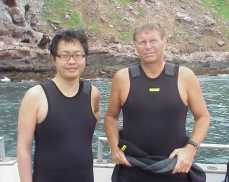 It was natural that I would team up with Charlie for the day's dives. We kit up and help each with our gear. Sean helped me tucked the skirting of my hood into my jacket. My first dive hood experience. With the zipped up jacket on top of the farmer john suit, and the hood, I felt completely wrapped up, just like a bak-chang. Hmm, the absolute tight squeeze must be what rubber jumpsuit fetishists are raving about. I put on my mask with more than the usual effort, ensuring that the silicon skirting is below the hood. And then I realised that I had not pushed all my hair under the hood, and had to push them out from under the mask skirting and then under the hood. Then I donned my BC and tank and pulled on the thin gloves which I got from Ronnie. Finally, other then my fins, I was ready. Charlie was ready, too; we sat down, checked each other's content gauges and waited for the dry suits to get into water. I asked Charlie to lead the dive, as it was not his first dive at that spot. "We shall descend by the anchor line," that was all he said.
It was natural that I would team up with Charlie for the day's dives. We kit up and help each with our gear. Sean helped me tucked the skirting of my hood into my jacket. My first dive hood experience. With the zipped up jacket on top of the farmer john suit, and the hood, I felt completely wrapped up, just like a bak-chang. Hmm, the absolute tight squeeze must be what rubber jumpsuit fetishists are raving about. I put on my mask with more than the usual effort, ensuring that the silicon skirting is below the hood. And then I realised that I had not pushed all my hair under the hood, and had to push them out from under the mask skirting and then under the hood. Then I donned my BC and tank and pulled on the thin gloves which I got from Ronnie. Finally, other then my fins, I was ready. Charlie was ready, too; we sat down, checked each other's content gauges and waited for the dry suits to get into water. I asked Charlie to lead the dive, as it was not his first dive at that spot. "We shall descend by the anchor line," that was all he said.
Soon, the dry suits were in the water with the video ensemble. Charlie and I gingerly proceeded to the starboard side and donned our fins. I entered the water with a nicely executed straddle jump, then checked to see that the 10-kg weight belt was still around my waist and that the BC straps had not given way. All seemed to be fine, so I gave the OK sign to the people above, PADI style - with a fist over my head. Charlie was soon with me in the water.
We swam to the anchor line. Charlie gave me the thumb down sign, and I acknowledged. So far, I only felt some slivers of coldness around my ankles and mouth, the air trapped in the tight wet suit having kept out the cold water. In tropical waters, I would ordinarily pull open my wet suit to let the trapped air out and seawater in; but here, I decided to let the air stay where it was trapped. As I pulled myself down the anchor line, I was glad for the 10-kg that was helping me to counter the buoyant trapped air. I began to feel the cold water seeping through my gloves and leg holes as we descended deeper. I only gave a glance to the gamboling sea lions at the 10-metre mark, as I was concentrating on gauging how far had the cold seepage gone during the whole descent. At the same time, I was very conscious of my hard breathing. At the bottom, I checked my Suunto; 14 metres, and 15° C. WOW - my coldest dive to date! Visibility was about 8 metres. I checked my content gauge - 2500 psi. I was breathing hard! Because it was 3000 psi on the boat.
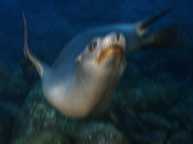 Charlie and I okayed to each other, then he took off in a northerly direction. I followed, still amazed that I was quite comfortable in the 15° C water. I supposed the tight squeeze of the suit gave me some degree of security. After a while I started to take in the surrounding. The sloping sea bed was all rocky; there were plenty of sea urchins, sea cucumbers and starfish. Swimming around were the bright orange garibaldis and the dull coloured small rock bass. There wasn't really much else to see. After finning for about 40 metres, Charlie changed direction, and we went back the way we came. Same scenery, but I began to feel cold. I had to put more effort at finning. My knees and ankles seemed to have stiffened somewhat. I tucked my hands under my armpit. We passed by the anchor, and headed into a team of 4 sea lions. I kept my hands close to my body. One of the sea lions rushed head-on to me, it was about 1 metre in length. Then about 1 metre from my mask, its mouth yawned open, and I could make out its sharp teeth. It continued its rush towards me and at the last moment, it closed its mouth and swerved away. I wasn't sure if I flinched, because the cold had slowed down my reaction. The sea lion continued swimming around me, twisting and turning. It was nice to see it swimming beside me, it actually looked docile. Another sea lion was swimming around Charlie, it started to let out air bubbles from its mouth; I wasn't sure if that was natural, or if it was trying to imitate our bubbling selves.
Charlie and I okayed to each other, then he took off in a northerly direction. I followed, still amazed that I was quite comfortable in the 15° C water. I supposed the tight squeeze of the suit gave me some degree of security. After a while I started to take in the surrounding. The sloping sea bed was all rocky; there were plenty of sea urchins, sea cucumbers and starfish. Swimming around were the bright orange garibaldis and the dull coloured small rock bass. There wasn't really much else to see. After finning for about 40 metres, Charlie changed direction, and we went back the way we came. Same scenery, but I began to feel cold. I had to put more effort at finning. My knees and ankles seemed to have stiffened somewhat. I tucked my hands under my armpit. We passed by the anchor, and headed into a team of 4 sea lions. I kept my hands close to my body. One of the sea lions rushed head-on to me, it was about 1 metre in length. Then about 1 metre from my mask, its mouth yawned open, and I could make out its sharp teeth. It continued its rush towards me and at the last moment, it closed its mouth and swerved away. I wasn't sure if I flinched, because the cold had slowed down my reaction. The sea lion continued swimming around me, twisting and turning. It was nice to see it swimming beside me, it actually looked docile. Another sea lion was swimming around Charlie, it started to let out air bubbles from its mouth; I wasn't sure if that was natural, or if it was trying to imitate our bubbling selves.
After a while, Charlie showed me his content gauge. The needle had reached the red zone. I gave him the thumb up sign, and he acknowledged. My gauge was still at the 1000-psi mark, but Charlie had started the dive with 2200 psi. We found the anchor line and started our ascent. Then Charlie started pointing at my back, my tank had gotten loose. I was not aware of it and didn't understand how the strap had loosened letting the tank slipped down. I managed to get the tank under my arm and we proceeded to the 6-metre depth. We stopped there for a minute or more, while Charlie tried to get my tank back into the strapped position, to no avail.
We then proceeded to the surface. I swam to the stern of the boat with my tank under my arm. Charlie swam behind me, to watch out for further mishaps. Somehow, I got to the step ladder and clung to it while John and Sean tried to get it out of water. In the process, I had to release the regulator mouthpiece. I forgot about my snorkel, and swallowed a few mouthfuls of cold seawater as the choppy sea pushed me against the step ladder. The water didn't taste as salty as those at home. In the end, John managed to untangle the tubes from the BC strap and got the tank off me. I took off my fins and climbed up the boat with Charlie beside me.
The dive had lasted 33 minutes. We were the first pair to come up. I took off the gloves, the BC, the mask and the hood. I kept my jacket on, because I could feel the chilly wind in my face and hair. I inspected my fingers, they hadn't wrinkled, seemed like Ronnie's gloves were working. Charlie quickly dekitted, took off his jacket and headed straight for the pee-cabin. Sean came out of the cabin with 2 cups of hot chocolate. I took one. Then I saw on the deck, a box of bagged chips and slices of melon and orange. I sat down and quaffed the hot chocolate, at the same time letting the heat warm my hands. Then the melon and orange slices and a packet of Lays followed the chocolate.
Soon, the others surfaced. All of them looked thoroughly pleased. The guys in the dry suits were sloughing off the top of part their suits as soon as they climbed aboard. They needed to pee. The disadvantage of dry suits, you can't pee underwater. But as we ate the fruit and chips out in the open deck with the incessant cold wind blowing, the dry suits simply looked much more attractive.
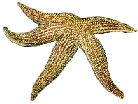


As the wind was getting stronger and sea wasn't getting calmer, John persuaded us to do the second dive at the same site. Nobody was against the idea, and Sean shifted the boat a bit, as the anchor had slipped during our wait for the second dive.
At about 12h30, all of us started to kit up again. We changed tanks, and this time I made doubly sure that mine was tightly strapped to the BC. I had only taken off the jacket for the short time I was in the pee-cabin, and I had put it back on as soon as I finished my business. And I had not taken off my booties. This time, I managed to put on the hood all by myself, and put on my mask with less trouble. I donned my BC and pulled on the wet and cold gloves.
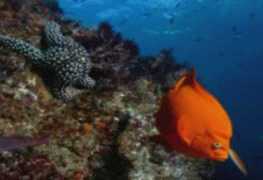 Then Charlie and I were back in the water. This time, we didn't use the anchor line to descend. With the thumb down sign, Charlie just sank under water. I emptied my BC of excess air, but did not start to sink, as I usually did in tropical waters. So I had to execute a surface dive to start descending. With a few kicks behind me, I was soon at the bottom. Depth: 17 metres. Visibility: 10 metres. Temperature: 16° C. It's one degree warmer than the first dive, but I could feel the cold now.
Then Charlie and I were back in the water. This time, we didn't use the anchor line to descend. With the thumb down sign, Charlie just sank under water. I emptied my BC of excess air, but did not start to sink, as I usually did in tropical waters. So I had to execute a surface dive to start descending. With a few kicks behind me, I was soon at the bottom. Depth: 17 metres. Visibility: 10 metres. Temperature: 16° C. It's one degree warmer than the first dive, but I could feel the cold now.
Charlie headed for the brightness of the video lights that the first pair of divers were using. I followed, and we saw that they were videoing the wreck of a small sport-fishing boat. I wouldn't have known that it was a sport-fishing boat if I had not read the dive reports on the Internet. The whole thing had completely collapsed, and sort of flattened out on the sandy seabed. We stayed there for about 5 minutes and then carried on our way in a southerly direction. Charlie seemed to be finning quite fast to me, I had to fin hard to keep up. Later, I learnt that he was searching for moray eels. We didn't see anything new, besides a small halibut in the sand near the wreck. Later on, I spotted a medium-size scorpion fish.
 Thirty minutes into the dive, I started to feel cold despite my vigorous finning. Charlie had led us on a zigzag trajectory covering the rocky slope at a relatively fast pace, hoping to spot a moray eel or two. Finally, he showed me his content gauge, the needle nearly reaching the red zone - time to ascend. We showed each other the thumb up sign and proceeded to the anchor line. We went up to the 6-metre depth and did a short decompression stop. I let Charlie dictate the time as his training required of him, my dive computer did not indicate the need for any decompression stop. After a few minutes, we proceeded to the surface.
Thirty minutes into the dive, I started to feel cold despite my vigorous finning. Charlie had led us on a zigzag trajectory covering the rocky slope at a relatively fast pace, hoping to spot a moray eel or two. Finally, he showed me his content gauge, the needle nearly reaching the red zone - time to ascend. We showed each other the thumb up sign and proceeded to the anchor line. We went up to the 6-metre depth and did a short decompression stop. I let Charlie dictate the time as his training required of him, my dive computer did not indicate the need for any decompression stop. After a few minutes, we proceeded to the surface.
Again we were the first pair to surface. This time, my tank stayed where it was strapped. After taking off my fins, I managed to climb up the stern, with the 10-kg belt and scuba ensemble. The first thing I noticed was that lunch had been laid out on the deck: Steaming corn soup and ham with roast beef sandwich. We quickly dekitted; Charlie went to the small room, and I stowed my compass and the dive computer. I'd decided that I'd had it for the day and would not do the third dive. Charlie and I helped ourselves to the soup, and watched the others surfaced. Then it started to rain. Sean quickly moved the lunch into the cabin.
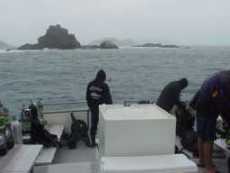 When everybody was safely on board, Sean started the boat. John had decided that it would be difficult to persuade us to do the third dive at the very same spot. The boat headed in a southerly direction to look for a dive site. The weather worsened gradually, and outside the sheltered cove, the waves were starting to look nasty. We passed the smaller islands, or big outcrops of bare rocks, with big waves crashing into them, breaking up into white foam. We ate our lunch and watched the rough sea played its tune against the rocks. After about 30 minutes, the captain managed to anchor at the relatively calm south-western side of the island.
When everybody was safely on board, Sean started the boat. John had decided that it would be difficult to persuade us to do the third dive at the very same spot. The boat headed in a southerly direction to look for a dive site. The weather worsened gradually, and outside the sheltered cove, the waves were starting to look nasty. We passed the smaller islands, or big outcrops of bare rocks, with big waves crashing into them, breaking up into white foam. We ate our lunch and watched the rough sea played its tune against the rocks. After about 30 minutes, the captain managed to anchor at the relatively calm south-western side of the island.
The elder one of the father-son duo had also decided not to do the third dive. So Charlie got to partner the son. When the 4 divers had gone into the water, the father and I changed out of our wet suits into dry clothes. I had begun to feel a bit queasy, although the boat was not rolling a lot. I could feel the digested cheese from the sandwich, coming up my throat. I started to feel a bit woozy and tired. I suspected that I had a slight case of hyperthermia and exhaustion, but I was not sure, as I had not trembled a single bit. So I drank a bottle of water and settle down in a corner in the cabin, and tried to nap, and not be sick.
I didn't know how long I stayed in my zombie-state. But I knew I had dismantled and stowed the BC and regulator from the tank of my last dive, together with the wet suit and hood. My fins, mask, gloves and booties were somewhere on the deck, all in different positions but tucked away in small corners. And in one of my hazy wakefulness, I saw that the divers had returned. It seemed that they had a great dive, just like the two previous ones; and they encountered a bunch of spider crabs! Inadvertently, they christened the site "Spider Crab Point" in their log books.
Sean then heaved to and turned the boat to San Diego. The rain had not stopped, and the sky was turning into a darker shade of grey. I stayed in my corner of the cabin, wavering on the border of hazy consciousness. The constant cheerful talk of my companions kept me out of the realm of dreams. Charlie and the son had changed into dry clothing, and were taking shelter from the rain in the cabin. While the other pair of divers retained their dry suits, and stayed on the deck, coming into the cabin for short periods, to partake in the hot coffee and cookies. I dared not join them, as I was afraid that I couldn't keep the food down.
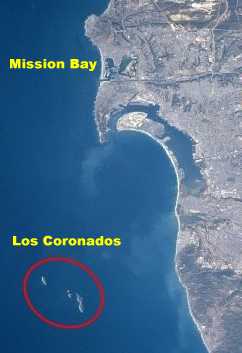 Sean was cheerfully announcing, at intervals, the time left for us to reach Mission Bay. The sky was quickly darkening. Here in San Diego, the winter sun sets early. 45 more minutes, Sean announced. I left my warm corner, went for a pee, then went around the deck and gathered my personal gear, and bundled the rented gear together. I returned to my corner and looked at my watch - it was about 5.40 p.m. I consulted the #34 time-table I had stowed in my jacket. There would be a bus arriving at about 6.35 p.m. I might just make it, otherwise, I would have to wait for another 30 minutes and catch the 7.05 p.m. bus.
Sean was cheerfully announcing, at intervals, the time left for us to reach Mission Bay. The sky was quickly darkening. Here in San Diego, the winter sun sets early. 45 more minutes, Sean announced. I left my warm corner, went for a pee, then went around the deck and gathered my personal gear, and bundled the rented gear together. I returned to my corner and looked at my watch - it was about 5.40 p.m. I consulted the #34 time-table I had stowed in my jacket. There would be a bus arriving at about 6.35 p.m. I might just make it, otherwise, I would have to wait for another 30 minutes and catch the 7.05 p.m. bus.
At about 6.10 p.m., Blue Explorer docked. All of us started to unload the gear onto a cart, that had been waiting for us, and pushed the gear to the dive shop. I had a quick talk to the person collecting the gear and rushed to the bus stop with my fins under my arm and bag on my back. It was 6.30 p.m. I was really glad to see the bus turned up at 6.40 p.m.
Tan Tsu Soo
La Jolla, 15 March 2003
 Go to Dive Club 854 home page.
Go to Dive Club 854 home page.